Yiping Bao
Kimi-VL Technical Report
Apr 10, 2025Abstract:We present Kimi-VL, an efficient open-source Mixture-of-Experts (MoE) vision-language model (VLM) that offers advanced multimodal reasoning, long-context understanding, and strong agent capabilities - all while activating only 2.8B parameters in its language decoder (Kimi-VL-A3B). Kimi-VL demonstrates strong performance across challenging domains: as a general-purpose VLM, Kimi-VL excels in multi-turn agent tasks (e.g., OSWorld), matching flagship models. Furthermore, it exhibits remarkable capabilities across diverse challenging vision language tasks, including college-level image and video comprehension, OCR, mathematical reasoning, and multi-image understanding. In comparative evaluations, it effectively competes with cutting-edge efficient VLMs such as GPT-4o-mini, Qwen2.5-VL-7B, and Gemma-3-12B-IT, while surpassing GPT-4o in several key domains. Kimi-VL also advances in processing long contexts and perceiving clearly. With a 128K extended context window, Kimi-VL can process diverse long inputs, achieving impressive scores of 64.5 on LongVideoBench and 35.1 on MMLongBench-Doc. Its native-resolution vision encoder, MoonViT, further allows it to see and understand ultra-high-resolution visual inputs, achieving 83.2 on InfoVQA and 34.5 on ScreenSpot-Pro, while maintaining lower computational cost for common tasks. Building upon Kimi-VL, we introduce an advanced long-thinking variant: Kimi-VL-Thinking. Developed through long chain-of-thought (CoT) supervised fine-tuning (SFT) and reinforcement learning (RL), this model exhibits strong long-horizon reasoning capabilities. It achieves scores of 61.7 on MMMU, 36.8 on MathVision, and 71.3 on MathVista while maintaining the compact 2.8B activated LLM parameters, setting a new standard for efficient multimodal thinking models. Code and models are publicly accessible at https://github.com/MoonshotAI/Kimi-VL.
Multi-modal Relation Distillation for Unified 3D Representation Learning
Jul 19, 2024

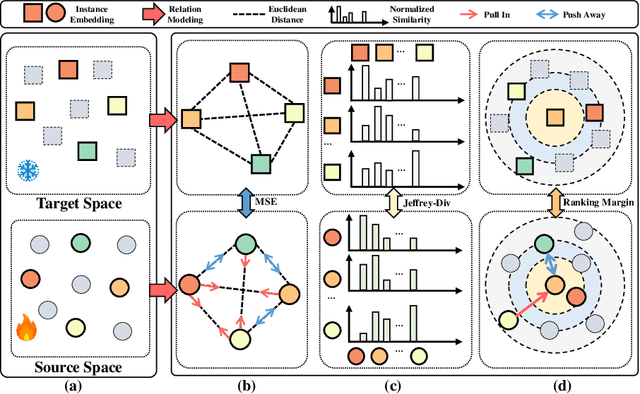

Abstract:Recent advancements in multi-modal pre-training for 3D point clouds have demonstrated promising results by aligning heterogeneous features across 3D shapes and their corresponding 2D images and language descriptions. However, current straightforward solutions often overlook intricate structural relations among samples, potentially limiting the full capabilities of multi-modal learning. To address this issue, we introduce Multi-modal Relation Distillation (MRD), a tri-modal pre-training framework, which is designed to effectively distill reputable large Vision-Language Models (VLM) into 3D backbones. MRD aims to capture both intra-relations within each modality as well as cross-relations between different modalities and produce more discriminative 3D shape representations. Notably, MRD achieves significant improvements in downstream zero-shot classification tasks and cross-modality retrieval tasks, delivering new state-of-the-art performance.
W2N:Switching From Weak Supervision to Noisy Supervision for Object Detection
Jul 25, 2022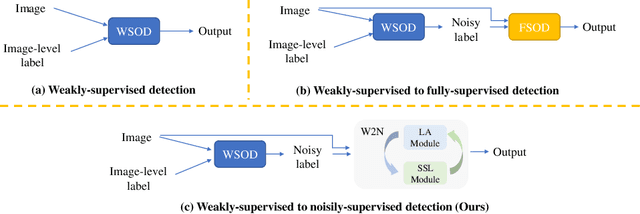
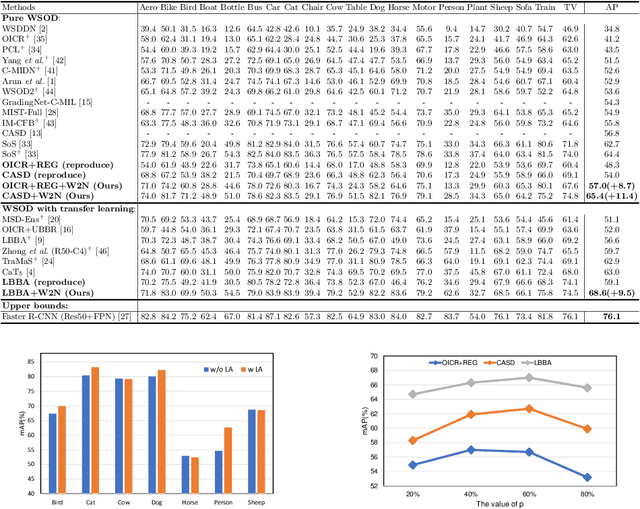
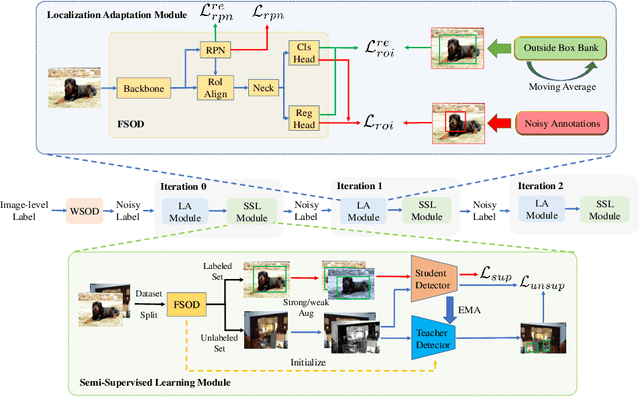
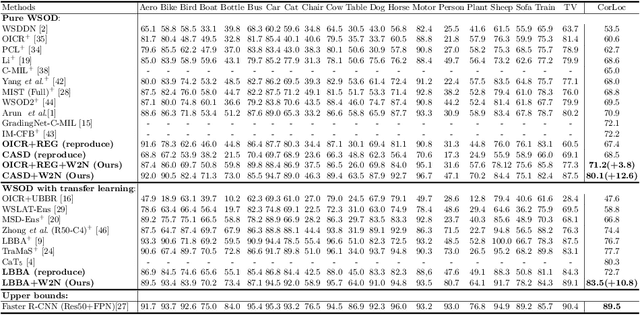
Abstract:Weakly-supervised object detection (WSOD) aims to train an object detector only requiring the image-level annotations. Recently, some works have managed to select the accurate boxes generated from a well-trained WSOD network to supervise a semi-supervised detection framework for better performance. However, these approaches simply divide the training set into labeled and unlabeled sets according to the image-level criteria, such that sufficient mislabeled or wrongly localized box predictions are chosen as pseudo ground-truths, resulting in a sub-optimal solution of detection performance. To overcome this issue, we propose a novel WSOD framework with a new paradigm that switches from weak supervision to noisy supervision (W2N). Generally, with given pseudo ground-truths generated from the well-trained WSOD network, we propose a two-module iterative training algorithm to refine pseudo labels and supervise better object detector progressively. In the localization adaptation module, we propose a regularization loss to reduce the proportion of discriminative parts in original pseudo ground-truths, obtaining better pseudo ground-truths for further training. In the semi-supervised module, we propose a two tasks instance-level split method to select high-quality labels for training a semi-supervised detector. Experimental results on different benchmarks verify the effectiveness of W2N, and our W2N outperforms all existing pure WSOD methods and transfer learning methods. Our code is publicly available at https://github.com/1170300714/w2n_wsod.
Prototypical Contrastive Language Image Pretraining
Jun 22, 2022



Abstract:Contrastive Language Image Pretraining (CLIP) received widespread attention since its learned representations can be transferred well to various downstream tasks. During CLIP training, the InfoNCE objective aims to align positive image-text pairs and separate negative ones. In this paper, we show a representation grouping effect during this process: the InfoNCE objective indirectly groups semantically similar representations together via randomly emerged within-modal anchors. We introduce Prototypical Contrastive Language Image Pretraining (ProtoCLIP) to enhance such grouping by boosting its efficiency and increasing its robustness against modality gap. Specifically, ProtoCLIP sets up prototype-level discrimination between image and text spaces, which efficiently transfers higher-level structural knowledge. We further propose Prototypical Back Translation (PBT) to decouple representation grouping from representation alignment, resulting in effective learning of meaningful representations under large modality gap. PBT also enables us to introduce additional external teachers with richer prior knowledge. ProtoCLIP is trained with an online episodic training strategy, which makes it can be scaled up to unlimited amounts of data. Combining the above novel designs, we train our ProtoCLIP on Conceptual Captions and achieved an +5.81% ImageNet linear probing improvement and an +2.01% ImageNet zero-shot classification improvement. Codes are available at https://github.com/megvii-research/protoclip.
Attend to Who You Are: Supervising Self-Attention for Keypoint Detection and Instance-Aware Association
Nov 25, 2021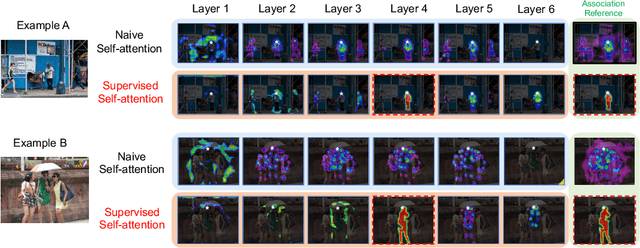
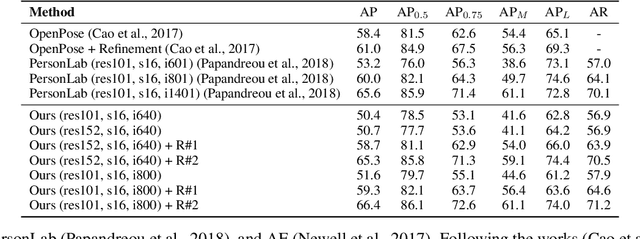

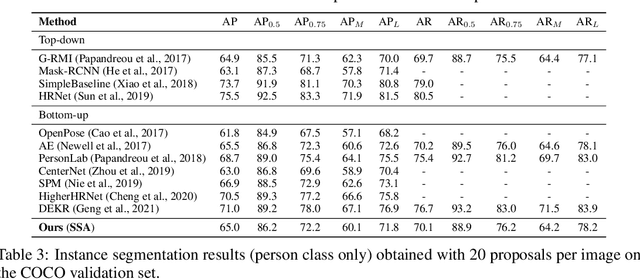
Abstract:This paper presents a new method to solve keypoint detection and instance association by using Transformer. For bottom-up multi-person pose estimation models, they need to detect keypoints and learn associative information between keypoints. We argue that these problems can be entirely solved by Transformer. Specifically, the self-attention in Transformer measures dependencies between any pair of locations, which can provide association information for keypoints grouping. However, the naive attention patterns are still not subjectively controlled, so there is no guarantee that the keypoints will always attend to the instances to which they belong. To address it we propose a novel approach of supervising self-attention for multi-person keypoint detection and instance association. By using instance masks to supervise self-attention to be instance-aware, we can assign the detected keypoints to their corresponding instances based on the pairwise attention scores, without using pre-defined offset vector fields or embedding like CNN-based bottom-up models. An additional benefit of our method is that the instance segmentation results of any number of people can be directly obtained from the supervised attention matrix, thereby simplifying the pixel assignment pipeline. The experiments on the COCO multi-person keypoint detection challenge and person instance segmentation task demonstrate the effectiveness and simplicity of the proposed method and show a promising way to control self-attention behavior for specific purposes.
General Instance Distillation for Object Detection
Mar 03, 2021



Abstract:In recent years, knowledge distillation has been proved to be an effective solution for model compression. This approach can make lightweight student models acquire the knowledge extracted from cumbersome teacher models. However, previous distillation methods of detection have weak generalization for different detection frameworks and rely heavily on ground truth (GT), ignoring the valuable relation information between instances. Thus, we propose a novel distillation method for detection tasks based on discriminative instances without considering the positive or negative distinguished by GT, which is called general instance distillation (GID). Our approach contains a general instance selection module (GISM) to make full use of feature-based, relation-based and response-based knowledge for distillation. Extensive results demonstrate that the student model achieves significant AP improvement and even outperforms the teacher in various detection frameworks. Specifically, RetinaNet with ResNet-50 achieves 39.1% in mAP with GID on COCO dataset, which surpasses the baseline 36.2% by 2.9%, and even better than the ResNet-101 based teacher model with 38.1% AP.
ThunderNet: Towards Real-time Generic Object Detection
Mar 28, 2019



Abstract:Real-time generic object detection on mobile platforms is a crucial but challenging computer vision task. However, previous CNN-based detectors suffer from enormous computational cost, which hinders them from real-time inference in computation-constrained scenarios. In this paper, we investigate the effectiveness of two-stage detectors in real-time generic detection and propose a lightweight two-stage detector named ThunderNet. In the backbone part, we analyze the drawbacks in previous lightweight backbones and present a lightweight backbone designed for object detection. In the detection part, we exploit an extremely efficient RPN and detection head design. To generate more discriminative feature representation, we design two efficient architecture blocks, Context Enhancement Module and Spatial Attention Module. At last, we investigate the balance between the input resolution, the backbone, and the detection head. Compared with lightweight one-stage detectors, ThunderNet achieves superior performance with only 40% of the computational cost on PASCAL VOC and COCO benchmarks. Without bells and whistles, our model runs at 24.1 fps on an ARM-based device. To the best of our knowledge, this is the first real-time detector reported on ARM platforms. Code will be released for paper reproduction.
 Add to Chrome
Add to Chrome Add to Firefox
Add to Firefox Add to Edge
Add to Edge